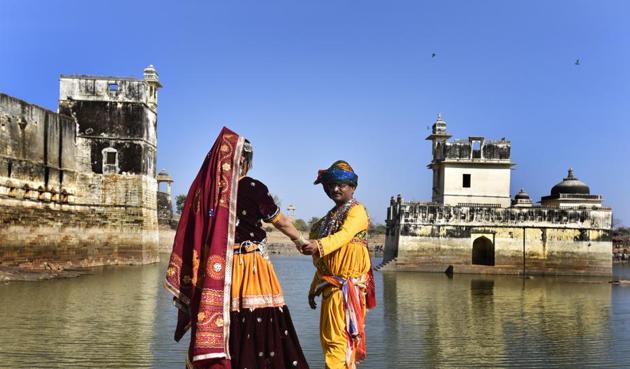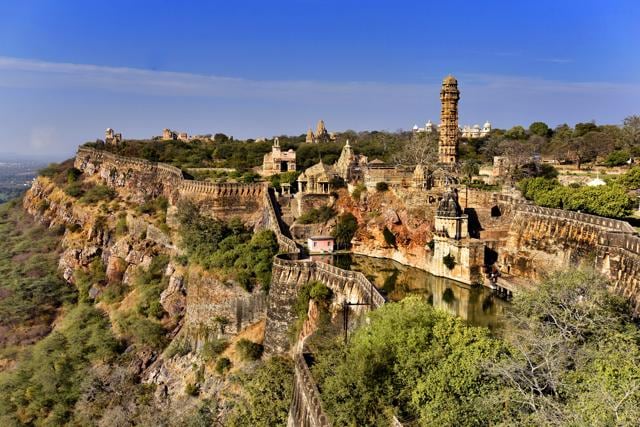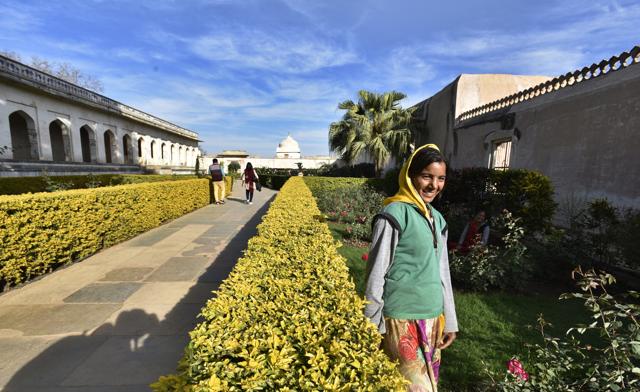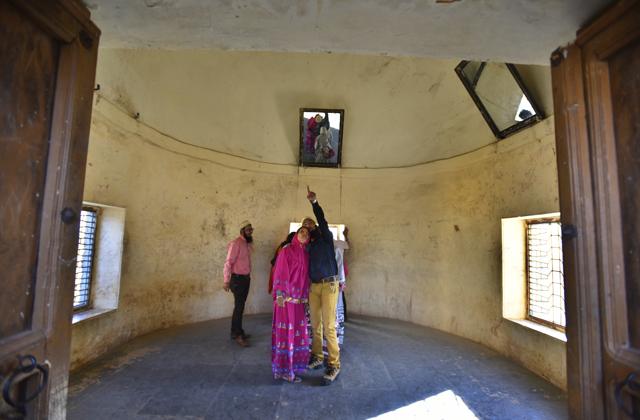Beautiful Padmini, a queen in history or a poetic fantasy?
Filmmaker Sanjay Leela Bhansali was in the eye of a storm recently for his film Padmavati. The film is still being shot. But who was Padmini? Did she even exist?
Rani Padmini Palace is only a small section of the sprawling Chittorgarh Fort. But it attracts a steady stream of visitors every day. It is also among the best maintained and tended-to sections of the fort, with a blooming rose garden near the entrance. And though visitors have to buy an entrance ticket to the fort, it is only at the gates of Rani Padmini Palace that a security guard will actually ask for the ticket, before letting in visitors. The attention and the screening both seem appropriate to the memory of a queen, whose unparalleled beauty is said to have been the reason for Alauddin Khilji’s 1303 attack on Chittorgarh.

“Rani Padmini was the most beautiful queen ever. Her skin was so fair, that if she had paan, you could see the beetlenut leaf juice going down her throat,” says 72-year-old Madhav Lal Mali. Mali was born inside the Chittorgarh fort and has spent his life there. His son sells books outside the Rana Kumbha Palace that narrate the stories of Chittor’s many legendary characters – Meerabai, Maharana Pratap, and of course Rani Padmini. But the old man firmly says that Rani Padmini is the most popular of all Chittorgarh’s historical characters. The story of her beauty and tragic death is one that has been passed down the centuries and one that every child born in Chittorgarh learns to accept and respect from an early age, without questioning its authenticity. It’s a story that is repeated by priests whose families have served at the various temples within the fort for generations, and by tour guides to their rapt eager audiences.
“Rani Padmini was the most beautiful queen ever. Her skin was so fair, that if she had paan, you could see the beetlenut leaf juice going down her throat,” says 72-year-old Madhav Lal Mali, who was born inside the Chittorgarh fort and has spent his life there
“At least 50 per cent of the tourists coming to Chittorgarh are primarily interested in hearing about Rani Padmini or seeing her palace,” says Bharat Singh a guide in Chittorgarh. The interest is not misplaced. The popular story about Padmini has everything to peak interest – romance, intrigue and tragedy. “Especially since Sanjay Leela Bhansali announced his film Padmavati, based on Rani Padmini, tourist interest in her and her palace has grown. People keep asking whether the shooting will be done here and when,” says guide Krishna Kant Sharma.

The Chittorgarh Fort is no stranger to film shoots. Bharat Singh points out the parapet on which Waheeda Rehman had danced to the tunes of “Aaj phir jeene ki tamanna hai…” as Dev Anand looked on, in the film Guide, or the spot where Deepika Padukone and Ranbir Kapoor had sat chatting and watching the sunset in Yeh Jawani Hai Deewani. But Bhansali, even if he had had plans to shoot in Chittorgarh, was stopped in his tracks in Jaipur, by members of the Sri Rajput Karni Sena, an organisation of Rajputs founded in 2006. Something about Bhansali’s alleged portrayal of the life and times of the queen, displeased the Rajputs.
The Legend of Rani Padmini
Legend has it that Alauddin Khilji, who ruled Delhi and other parts of India between 1296 and 1316, heard of Padmini’s beauty and was so smitten by her, that he attacked Chittorgarh with the desire to win her for himself. But the walls of the fort were impregnable and after months of laying siege, as neither army managed to gain an upper hand, Khilji requested that he be allowed to see a reflection of Rani Padmini’s face. The story goes that to save his war-weary people, the Rana agreed. But a glimpse of Padmini’s beauty so filled Khilji with lust, that he got the Rana outside the fort on the pretext of escorting him out and then had him captured by his own soldiers. A demand was made for Padmini in return of the Rana’s release. Padmini decided to match deceit with deceit and sent word that she and her women-in-waiting would come to Khilji, but she wanted to see her husband a last time before surrendering herself to Khilji. Khilji agreed. But instead of Padmini and the other ladies, the best Rajput warriors went in the covered palanquins and managed to have the Rana released from Khilji’s camp. An enraged Khilji attacked Chittorgarh with renewed force and when it became clear to the Rajputs that there was no scope of winning against him, the Rana decided to throw open the fort gates and fight till death. The night before, Padmini and other women of Chittor committed jauhar – a process of self immolation – rather than suffer the indignity of falling into the hands of the enemy. Ashes and bones was all that greeted Khilji when he finally entered the fort.

What historians say
Most of this story, however, of Padmini’s unmatched beauty and Khilji attacking Chittorgarh for her has little or no historical backing and has roots in poet Malik Muhammad Jayasi’s 1540 work of fiction the Padmavat. “Jayasi makes it very clear that he is writing fiction and not history,” says Lokendra Singh Chundawat, head of the department of History at the Maharan Pratap Post Graduate College in Chittorgarh. “In 1303, Khilji did attack Chittorgarh, which was under the rule of Rana Ratan Singh at the time. But the attack had nothing to do with Rani Padmini. There is no mention in history of Padmini’s beauty. The attack on Chittorgarh was fueled by Khilji’s desire to expand his control over India. And Chittorgarh was not the only kingdom that he had attacked in Rajasthan. He had attacked Ranathambhore, Jalore and Jaisalmer before 1303.”
While Chundawat feels that the extent of truth in Rani Padmini’s story ends with her being Rana Ratan Singh’s wife, who committed Jauhar before the Rana fell in battle, many historians question the authenticity even of Padmini’s existence. “There was no Rani Padmini. It is likely that Rana Ratan Singh was married at the time of the battle in 1303, for they would marry early then and marry many times, but there is no mention anywhere of his wife’s name,” says historian Harbans Mukhia. “In those days they were very strict about the chastity of the queens and even mentioning their names would be unacceptable according to their ideas of chastity.” He adds: “In fact, there is also no mention of any Jauhar done by Ratan Singh’s wife or other women in the fort at the time. Even Amir Khusro, who accompanies Khilji and recorded the details of that battle in his writings, doesn’t mention a Jauhar. But the practice was common among Rajput women of the time, so it might well have been done.”
“There was no Rani Padmini. It is likely that Rana Ratan Singh was married at the time of the battle in 1303, for they would marry early then and marry many times, but there is no mention anywhere of his wife’s name,” says historian Harbans Mukhia.
Ground reality
The story of Padmini, however, makes one of the most popular folklores in Chittorgarh, with locals quick to either negate any questioning of it, or eager to plug possible holes in the story. Sharma, for example, takes it on himself to answer how word of Padmini’s beauty could have spread, if the queen remained in purdah. His theory? “That degree of beauty can’t go unnoticed. May be some children who went to the palace saw her and talked about it.”
Ironically even the Archaeological Survey of India (ASI) and Rajasthan Tourism seem to have bought into the legend. The state tourism department mentions the legend of Padmini’s beauty and Khilji’s attraction both on its website (though it says the queen’s reflection was shown to Khilji in the waters of a pond and not a mirror) and in a light-and-sound show conducted at the fort. An officer of the tourism department who doesn’t want to be named, says that the department is concerned about providing facilities to tourists and giving them some information about the palace and any information about any place might well be the popular narrative and not backed by historical evidence. “History is not our concern,” he says.
Read: Padmavati a fictional character with no connection to history, says historian
The ASI has a plaque outside Padmini Palace identifying it as such. The plaque also says that this is the place where Khilji is said to have seen Rani Padmini. But Mukhia is quick to say that there was no Padmini Palace in 1303, just as there was no Rani Padmini. “All these structures were much later day additions to the fort,” he says. The ASI did not reply to Hindustan Times’ email and calls, but Mukhia adds that the ASI lending its name to the fiction is damaging to history. “It is a kind of authentication of the story,” he points out.
Meanwhile, mirrors have been placed in the room from where Khilji is said to have seen Padmini, to give tourists to better experience the story. Many guides do, however, inform that these mirrors were installed at a later date.
Why the Rajputs revere her
The story of the brave queen is important to the Rajputs. As Chundwat points out while many later day Rajputs entered into matrimonial alliances with the Mughals, Padmini chose to commit jauhar rather than fall into the enemy’s hands. But whereas the Rajputs have accepted and celebrated Jayasi’s depiction of Padmini and her fight for her honour, the part about her reflection being shown to Khilji doesn’t sit well with them. “Even today if someone tells a man to show him his wife’s face because she is very pretty, no man will accept. It is against Rajput tradition. And a queen who can burn herself rather than fall into the enemy’s hands, would never have accepted it either,” says Narpat Singh Bhati, treasurer of the Jauhar Smriti Sansthan, which honours the memory of the three queens of Chittorgarh – Padmini and two others - who had at different times committed Jauhar, by organising an annual Juahar Mela. The organisation also runs a girls hostel. The girls – mostly in their early twenties – have a deep respect for Padmini. “She is an inspiration for us. If in those days she could be so brave and go to such extents to protect her honour, so can we,” gushes one girl.

But even role-models need proper branding. And so there is a need to sanitise Padmini’s background. While Jayasi’s poem traces her origin to Sinhal Dweep or Sri Lanka and says Rana Ratan Singh won her hand after a prolonged courtship, locals say she was from Rajasthan – from a place called Pongal Wati.
Meanwhile, the mood in Chittorgarh is volatile. Locals object to an alleged romantic dream sequence between Padmini and Khilji in Sanjay Leela Bhansali’s film Padmavati. The film is still under production. While Bhati alludes to leaked Youtube videos as the source of their information, one of the Karni Sena founders, Lokendra Singh Kalvi, says they came to know of it from interviews given by actor Ranveer Singh, who is reportedly protraying the character of Khilji in the film. Bhansali has clarified that there is no romantic scenes between Khilji and Padmini. “We want that for all such historical films, there should be a system of pre-censorship,” says Kalvi.
Her appeal today
Padmini’s rise as a character of national history and her resonance with the audience today, says Mukhia, has more to do with the 19th century symbolism of national pride, than the history of her time. “The story fitted with the later-day stereotypes of a chaste Hindu woman trying to protect her honour and the lusty Muslim ruler. It also enjoys relevance in mobilizing anti-minority sentiments in the current political situation in the country,” he says.
How the fictional story of a fictitious character has managed to become central to the Rajput history of the time might also have something to do with India’s tradition of oral history. “Though Padmini’s story was not oral, it was taken up by the proponents of oral history and such word-of-mouth storytelling has more reach than structured history taught within the walls of a classroom,” agrees Mukhia.
But while the controversy and unrest surrounding a character either historical or historical fiction is unwarranted, in a purely cultural debate, Rachel Dwyer, a professor of Indian Cultures and Cinema in London, questions “why should we value history more than mythology”, which often gives one a peak into the cultures, values and societies in which they were written. Padmini is not the only fictional character that has captured public imagination in a way that it seems to become real. There are other such examples in India and across the world. The Dilip Kumar-Madhubala film, Mughal-e-Azam, made the romance between prince Salim and courtesan Anarkali popular history. Jodha Bai is believed by historians to have been married to Jahangir, but Bollywood as shown her to be the wife of Jahangir’s father Akbar. In France Marianne is a symbol of the French Republic and an allegory of liberty, equality and fraternity. No one is sure whether King Arthur, Britain’s legendary monarch who supposedly defended his kingdom against Saxon invaders, ever really existed. But he is a part of British culture.
The problem then is not in accepting legends, but being so rigid in our acceptance, that we fail to allow it when someone re-imagines it a little differently from the accepted script.





